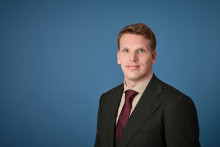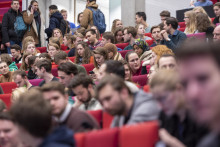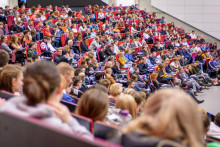The field of Vibrations and Acoustics is an important area of research within the UT and in the faculty of Engineering (CTW). CTW has built an excellent reputation in the field, both nationally and internationally. Professors Tijdeman and De Boer have been granted an research project to create quieter computers from the American company Intel. There are also projects for quieter equipment which European companies sponsor. This month began a large European project in the area of Thermo-Acoustics in which the UT's Faculty of Engineering is an important partner. It is about the roaring sound that can be caused by large flames.
The European project is called DESIRE - an acronym for design and demonstration of highly reliable low NOx combustion systems for gas turbines - and will span three years. Partners in this project include Siemens Power Generation (Germany), PowerGen (England), KEMA (The Netherlands) and the German Center for Aviation and Space Travel (DLR). The total project will cost 6 million Euro, half of which is funded by the European Union.
The research concerns large European industrial gas turbines with power up to 300 MW, which are used to generate electricity. An over-measure of oxygen is used at combustion to diminish the outburst of nitrogen compounds (NOx) and to increase efficiency. However, the more oxygen is added, the more probable it is that thermo-acoustic instability will occur. The sonic field which is produced by the flame causes fluctuations in the flow of the flame itself. These fluctuations cause the flame to make even more noise. Eventually the acoustic pressure can get so high that the walls of the combustion chamber can collapse. One of the project's goals is to determine the connection between the sound originating from the flame and the vibration of the wall using advanced models. This will allow experts to make estimations as to at what point the wall collapses and then to advise how to delay that moment. Ultimately this should result in cleaner combustion and more reliable gas turbines.
From the Faculty of Engineering, the departments of Thermal Engineering (senior lecturer Jim Kok) and Applied Mechanics (Professor AndrÚ de Boer) will work together on this project. Two PhD students (ir. Rob Huls and ir. Jaap van Kampen) have been hired for the project. They will work with project leader Jim Kok on developing computer models for the behavior of the flame and the acoustic behavior of such a large gas turbine.
Concurrently an experimental set-up is being designed which will be built in the new gas laboratory in hall I of the CTW building. During the experiments a combustion chamber with a flame in it under 5 bar pressure and with a power of 500 kW will be monitored (for comparison: a CH-installation at home produces 25 kW).Part of the wall will consist of windows. Through these windows a laser-doppler vibration sensor will measure the vibration of the wall and correlate it with signals from the pressure sensors. Additionally a 400 Hz Laser Induced Fluorescence system, the only one of its kind in the Netherlands, allows viewing of the shape of the flame through these windows. This should offer more insight in the way the flame responds to the acoustic field. The implementation of the laser-sensor will be handled by dr. Genie Stoffels and Professor Theo van der Meer.
Eventually Siemens will apply the results in the design of its largest gas turbine (the V94.3A) and test it in an English power plant.







